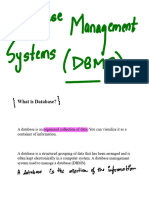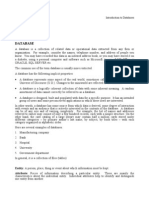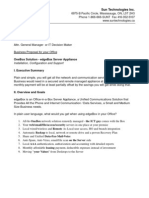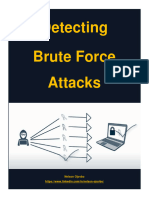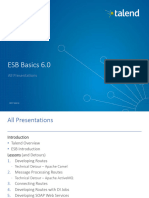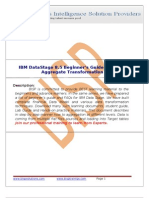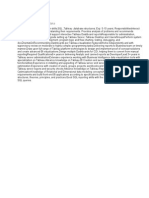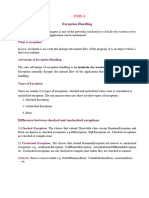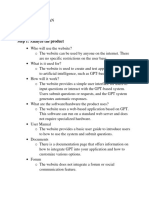CS-IP-Learning-Hub
Important Questions and Notes
Menu
Chapter 8 Introduction to DBMS Notes: Important Points
July 5, 2024 by csiplearninghub
Share with others
Chapter 8 Introduction to DBMS Notes: Important Points
Chapter 8 Introduction to DBMS Notes: Important Points
Introduction to DBMS
INTRODUCTION
A database is an organized collection of data. It is considered as a container of information.
In the manual system, you would maintain several files with different bits of information while
in the computerized system you would use database programs such as Microsoft Access,
LibreOffice Base, OpenOffice.org Base, and MySQL, to organize the data as per your business
need.
Data and Information
The raw facts and figures is called data. The facts may be related to any person, place, activity
or things. The examples of data are marks scored by the students, numbers of items sold,
employee names, product names, addresses, tax codes, registration etc.
Information is the processed or organized form of data. If data is not correct, the information
obtained by processing such data may not be correct. For example, marks obtained by
students and their roll
numbers is the data, while the report card/sheet is the information.
Similarly the temperature recorded is data which can be processed to find out the maximum or
minimum temperature of day and night.
Databases and DBMS
A database is a collection of logically related data items stored in an organised manner. The
information being
stored in a database can be added, modified, deleted or displayed according to the
requirements of the user. for example the phone book can be considered a simple database
which contains Name and Mobile number in an orderly manner
The software that is used to create, update and retrieve data is known as database
management system (DBMS). It facilitates planning and maintenance of the database for the
user. Some of the common examples of DBMS are MS Access, Open Office or LibreOffice base,
Oracle, MySQL.
Advantages of Database
1) Organised Storage : The data in the database is stored in an organised manner, so that
retrieval of the required data is fast and accurate.
2) Data Analysis : A database helps in analysis of data based on certain criteria.
3) Reduces Data Redundancy : Database reduces data redundancy (duplication of data)
4) Sharing of Data : In a database, the users of the database can share the data among
themselves.
5) Data Integrity : Data integrity means that the data is accurate and consistent in the
database.
6) Data Security : Database provides data security as only authorized users are allowed to
access the database and their identity are authenticated by using a username and password.
7) Privacy : The privacy rule in a database states that only the authorized users can access a
database according to its privacy constraints.
8) Backup and Recovery : Database Management System automatically takes care of backup
and recovery.
Data Models
A structure of database that describes the manner in which data will be stored and retrieved is
known as data model.
A data model consists of components for describing the data, relationships among them and
the constraints
that hold data.
Types of Data Models
1. Hierarchical Data Model
In this model the data is organized into a tree like structure. The data is stored in the form of
records. All these records are linked to each other at various levels, thereby forming a
hierarchy. For example
Introduction to DBMS – Hierarchical Data Model
2. Network Data Model
This model is used to represent the many-to-many relationship among the database
constraints. In other words we can say that in this model, multiple records are linked to same
master file.
Introduction to DBMS – Network Data Model
3. Relational Data Model
This data model is based on the principle of setting relationships between two or more tables
of the same database. It is the most commonly used database model.
The Relational Database Model was proposed in 1970 by E. F. Codd. The data elements are
stored in different tables and are related through the use of common fields. So relations are
set between tables based on common fields. That is why this model is termed as relational
database model.
Relational Database Terminology
Entity: It is a real world object about which information is to be stored in a database. Each
entity is a collection of attributes associated with it. for example roll number, name, admission
number, etc., are attributes associated with the entity student. These attributes are
represented in the form of columns.
Table: A table is a collection of logically related records. It is organised as a set of columns,
and can have any number of rows.
Field or Columns or attributes : A field is the smallest entity in the database. Fields are
presented as columns within a table. A field holds the data values of one type of data for
several persons. For example, in the Employee table the field “Emp Name” will hold the names
of employees of an organisation.
Record or Row or Tuple – The data values for all the fields related to a person or object is called
a record. It is
presented as rows within a table.
Primary Key : A primary key or simply a key is a field that uniquely identifies each and every
record in a table.
Foreign key : The foreign key identifies a column or set of columns in one (referencing) table
that refers to a column or set of columns in another (referenced) table.
Primary Key vs Foreign Key
NOTE : In Student Registration Table, ‘Enrolment_Number’ is the primary key and in the
Student Marks Table, ‘Roll_Number’ is the primary key, whereas ‘Enrollment_Number’ is the
foreign key.
Composite Primary Key : When primary key constraint is applied on one or more columns then
it is known as Composite Primary Key.
Relational Database : A relational database is a collection of related tables.
Data Values : Data values are the raw data represented in numeric, character or alphanumeric
form. Examples of data values are ‘Abhinav Bindra’, ‘26’ ‘shooting’, “Chandigarh”, “10-12-
2018”, etc.
NOTE: A collection of fields make a record, a collection of records make a table and a collection
of tables make a database
Objects of an RDBMS
An object in a database is a structure or a feature that is used to store, represent or retrieve
data. In fact a database is a collection of these objects given below
Table : – A table is the basic unit of any DBMS. The data is first stored in tables in row and
column format.
Forms : – A form is a feature of a database using which we can enter data in a table in an easy
and user friendly manner. The data entered through the forms is stored in tables.
Queries : – A query is used to retrieve the desired information from the database. In simple
terms, it is a question asked from the database.
Reports : – A report is the formatted result of queries which contains data required for
decision-making and analysis.
SUMMARY
1. The raw facts constitutes data.
2. Information is the processed or organised form of data.
3. A database is a collection of logically related data items stored in an organised manner.
4. The software that is used to create, update and retrieve data is known as database
management system (DBMS).
5. Some of the common examples of DBMS are MS Access, Open Office or LibreOffice Base,
Oracle, Ingress, MySQL.
6. Data Model is the structure of database and it describes the manner in which data will
be stored and retrieved.
7. There are different data models, such as hierarchical data model, network data model
and relational data model.
8. In Hierarchical Data Model, the data is organised into a tree like structure. The data is
stored in the form of linked records.
9. In Network Data model, multiple records are linked to same master file.
10. The Relational data model is based on the principle of setting relationships between
two or more tables of the same database.
11. Entity is a real world object about which information is to be stored in a database.
12. The details associated with the entity are called attributes.
13. A table is a collection of logically related records. It is organised as a set of columns,
and can have any number of rows.
14. A field is the smallest entity in the database. These are individual record
characteristics and are presented as columns within a table.
15. Data values are the raw data represented in numeric, character or alphanumeric form.
16. The data values for all the fields related to a person or object is called a record. It is
presented as rows within a table.
17. A primary key is a field that uniquely identifies a row in a table.
18. This foreign key helps to build a relation between two or more tables in a database.
19. All the field values that are eligible to be the primary key are the candidate keys for
that table.
20. Out of the candidate keys, one or two are made as primary keys. The others are the
alternate keys.
21. An object in a database is a structure or a feature that is used to store, represent or
retrieve data. The various objects in a database are tables, forms, reports and queries.
22. A form is a feature of a database using which we can enter data in a table in an easy
and user friendly manner.
23. A query is used to retrieve the desired information from the database.
24. The output of a query may be displayed in the form of reports.
Important links of Class X (IT – 402)
Unit 1: Digital Documentation (Advanced) using LibreOffice Writer
Chapter 1. Introduction to Styles – NOTES
Chapter 1. Introduction to Styles – Question Answers
Chapter 2. Working with Images – NOTES
Chapter 2. Working with Images – Question Answers
Chapter 3. Advanced features of Writer – NOTES
Chapter 3. Advanced features of Writer – Question Answers
Unit 2: Electronic Spreadsheet (Advanced) using LibreOffice Calc
Chapter 4. Analyse Data using Scenarios and Goal Seek – NOTES
Chapter 4. Analyse Data using Scenarios and Goal Seek – Question Answers
Chapter 5. Using Macros in Spreadsheet – NOTES
Chapter 5. Using Macros in Spreadsheet – Question Answers
Chapter 6. Linking Spreadsheet Data – NOTES
Chapter 6. Linking Spreadsheet Data – Question Answers
Chapter 7. Share and Review a Spreadsheet – NOTES
Chapter 7. Share and Review a Spreadsheet – Question Answers
UNIT 1: DIGITAL DOCUMENTATION (ADVANCED) – MCQ
UNIT-2: ELECTRONIC SPREADSHEET (ADVANCED) – MCQ
UNIT-3 RELATIONAL DATABASE MANAGEMENT SYSTEMS (BASIC) – MCQ
Disclaimer : I tried to give you the simple Notes of “Chapter 8 Introduction to DBMS Notes“ ,
but if you feel that there is/are mistakes in the Notes of “Chapter 8 Introduction to DBMS
Notes“ given above, you can directly contact me at csiplearninghub@gmail.com. NCERT Book
and Study material available on CBSE Website are used to create above article “Chapter 8
Introduction to DBMS Notes“
Chapter 8 Introduction to DBMS Notes: Important Points
Chapter 8 Introduction to DBMS Notes: Important Points
Chapter 8 Introduction to DBMS Notes: Important Points
Chapter 8 Introduction to DBMS Notes: Important Points
Chapter 8 Introduction to DBMS Notes: Important Points
Chapter 8 Introduction to DBMS Notes: Important Points
Chapter 8 Introduction to DBMS Notes: Important Points
Chapter 8 Introduction to DBMS Notes: Important Points
Chapter 8 Introduction to DBMS Notes: Important Points
Chapter 8 Introduction to DBMS Notes: Important Points
Chapter 8 Introduction to DBMS Notes: Important Points
Like this:
Loading...
Related
Unit 5 Green Skill Class 10 Online Quiz Best Quiz Entrepreneurial Skills Class 10 Best Quizzes Communication Skills Class
10 IT 402
Share with others
Python Loop Test Series
Ch 7 Share and Review Spreadsheet Question Answers
Ch 8 Introduction to Database Management System Questions Answers
Leave a Reply
Subscribe to Blog via Email
Enter your email address to subscribe to this blog and receive notifications of new posts by email.
Email Address
Subscribe
Join 367 other subscribers
About me
I am a teacher with more than 19 years of experience in education field. You can contact me at
csiplearninghub@gmail.com
Like For Update
Recently Added
Ch-2 Working with Images Class 10 Important MCQ March 6, 2025
Ch-3 Advanced Features of Writer Class 10 MCQ January 29, 2025
70+ Important MCQ Ch-1 Introduction to Styles Class 10 January 15, 2025
Class 11 Ch 4 NCERT Problem Solving Questions December 26, 2024
Class 11 Ch 4 Introduction to Problem Solving Notes Important Points December 17, 2024
Class 11 Encoding Schemes Notes: Important Points December 11, 2024
Class 9 IT Sample Paper 2024-25 Important for Exam December 9, 2024
Class 11 Number System Notes: Important Points December 6, 2024
Archives
Select Month
Select Topic
Artificial Intelligence Class 10 (4)
Assignment (3)
Binary File Handling (2)
Case Study Based (2)
Class 10 IT 402 QnA (60)
Class 10 IT Notes (20)
Class 11 Chapter wise MCQ (6)
Class 11 CS Notes (7)
Class 11 IP Notes (1)
Class 12 Chapter wise MCQ (10)
Class 12 CS Notes (1)
Class 12 IP Notes (5)
Class 9 IT 402 QnA (21)
Class 9 IT Notes (8)
CS Sample Paper (2)
Error Finding Questions (1)
File Handling (11)
IT-402 Book Solution (15)
IT-402 Practical (1)
IT-402 Sample Paper (10)
List in Python (5)
MySQL (6)
NCERT CS Solution (13)
NCERT IP Solution (7)
Networking (3)
One Mark Question (13)
Online Quiz (5)
Pandas (9)
Practical Paper Class 12 (2)
Python Conditional Statement Test (1)
Python Data Structure (2)
Python Dictionary (4)
Python Examples (8)
Python Fundamental Test Series (1)
Python Loop Test Series (35)
Python loops Practice Questions (1)
Python Modules (2)
Python Output based questions (2)
Python String (8)
Random in Python (2)
Review of Python (2)
Sample Paper IP (4)
Solved Test (2)
Sorting algorithm (4)
Sumita Arora Solution Class 11 (1)
Tuples in Python (2)
Contact Form
Name *
First Last
Email *
Comment or Message *
� Submit
Search …
Recently Added
Ch-2 Working with Images Class 10 Important MCQ
Ch-3 Advanced Features of Writer Class 10 MCQ
70+ Important MCQ Ch-1 Introduction to Styles Class 10
Class 11 Ch 4 NCERT Problem Solving Questions
Class 11 Ch 4 Introduction to Problem Solving Notes Important Points
Share your Valuable Feedback
Name *
First Last
Email *
Comment or Message *
Submit
Select Topic
Artificial Intelligence Class 10 (4)
Assignment (3)
Binary File Handling (2)
Case Study Based (2)
Class 10 IT 402 QnA (60)
Class 10 IT Notes (20)
Class 11 Chapter wise MCQ (6)
Class 11 CS Notes (7)
Class 11 IP Notes (1)
Class 12 Chapter wise MCQ (10)
Class 12 CS Notes (1)
Class 12 IP Notes (5)
Class 9 IT 402 QnA (21)
Class 9 IT Notes (8)
CS Sample Paper (2)
Error Finding Questions (1)
File Handling (11)
IT-402 Book Solution (15)
IT-402 Practical (1)
IT-402 Sample Paper (10)
List in Python (5)
MySQL (6)
NCERT CS Solution (13)
NCERT IP Solution (7)
Networking (3)
One Mark Question (13)
Online Quiz (5)
Pandas (9)
Practical Paper Class 12 (2)
Python Conditional Statement Test (1)
Python Data Structure (2)
Python Dictionary (4)
Python Examples (8)
Python Fundamental Test Series (1)
Python Loop Test Series (35)
Python loops Practice Questions (1)
Python Modules (2)
Python Output based questions (2)
Python String (8)
Random in Python (2)
Review of Python (2)
Sample Paper IP (4)
Solved Test (2)
Sorting algorithm (4)
Sumita Arora Solution Class 11 (1)
Tuples in Python (2)
© 2025 CS-IP-Learning-Hub • Built with GeneratePress

























